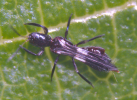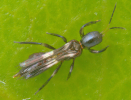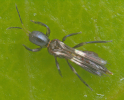 |
Scientific nameFranklinothrips vespiformis Crawford
Taxonomic positionThysanoptera: Terebrantia: Aeolothripidae
DiagnosisFemale: Fore wing broad and rounded at apex, with two dark cross bands. Fore wing with small subapical pale area. Maximum distal width of fore wing at most 2.9 times width of hind tibia. This species shows the striking sexual dimorphism in colour. In female antennal segment I-III yellow,
IV dark brown, scarcely paler than V, VI-IX dark brown; but in male all antennal segments are brown in colour. Antennal segments III and IV each with linear longitudinal sensory area. In female abdominal segments IV-VIII uniformly dark brown in contrast to yellow abdominal segments I- III and IX; but in male all abdominal segments are uniformly dark brown. Transverse bridge on tentorium thick and with a pair of
lamellae.
Male: Males (Fig. 5) are less ant-like in appearance, being smaller than females, with longer antennae, a less constricted waist, and commonly with paler wings but darker antennae. Larva: Reddish with hump-backed appearance (Fig. 7). Adult females are fast running, superficially resemble ants and bethylid wasps and the larvae are hump-backed (Mound & Renaud, 2005). Mound & Renaud (2005) reviewed the genus in detail, along with illustrations for all the species. 
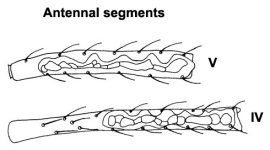 Fig. 1 & Fig. 2 Fig. 1 & Fig. 2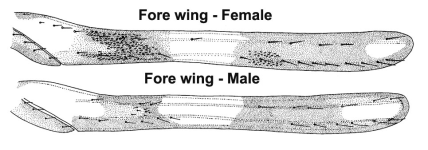 Fig. 3 Fig. 3
 Fig. 4. Female; Fig. 5. Male Fig. 4. Female; Fig. 5. Male Fig. 6. Female:Head / Antenna Fig. 6. Female:Head / Antenna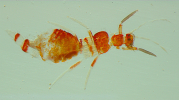 Fig. 7. Larva with hump-backed body Fig. 7. Larva with hump-backed bodyImagesDistributionU.S.A. (Arizona, California, Texas, Florida), Bermuda, Puerto Rico, Cuba, Jamaica, St. Vincent, Grenadines, Guadeloupe, Domican Republic, Martinique, Barbados, Antigua, Trinidad, Mexico, Nicardgua, Handuras, El Salvador, Brazil, Fiji, Japan, Thailand, New Caledonia, Australia (Queensland)
(Mound & Reynaud, 2005). India (Delhi; Karnataka). This constitutes the first record of the species from India (and Karnataka).
Hosts / Associated habitatFranklinothrips vespiformis, like the other members of the genus Franklinothrips, is an obligate predator. In Okinawa and Japan, Araraki and Okajima (1998) found the larvae and adults of Franklinothrips vespiformis preying on the pest species, Thrips palmi, on several vegetable crops and studied its biology.
References
|
